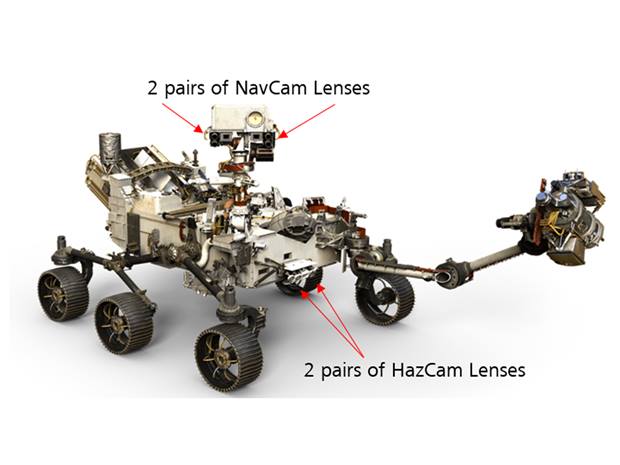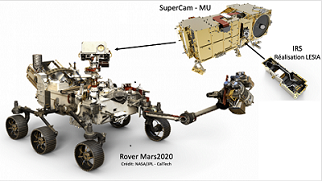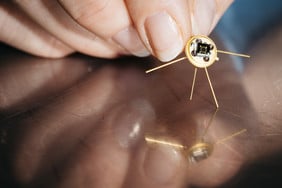Full company details
Teledyne Princeton Instruments
Bus. Unit of Teledyne Technologies
 3660 Quakerbridge Rd.
3660 Quakerbridge Rd.
Trenton, NJ 08619
United States
Phone: +1 609-587-9797
Toll-free: +1 877-474-2286
Photonic Instruments, Components Driving (and Steering) NASA’s Mars Rover
Photonics.com
Aug 2020Numerous photonic devices and applications are contributing to the pursuit of microbial life on Mars, or, more accurately, the quest to determine if, among other novel possibilities, such lifeforms once inhabited the Red Planet. Among abundant unique components on board NASA’s Mars rover Perseverance are lenses, mirrors, prisms, sensors, and cameras from industry developers. The rover’s mission began at Cape Canaveral, Fla., on July 30 and seeks to answer long-elusive questions about Earth’s next-door neighbor.
Assessing the potential habitability of Mars is among the rover’s daunting objectives; others include sample caching and planning for forthcoming human exploration. The rover is breaking down its principal assignments by studying the geological construction of the planet and its physical biosignatures. Spectrometers, such as the SHERLOC UV module that uses both Raman and luminescence spectroscopy, are vital to the processes the rover will perform to make its determinations.
Precision lenses meet spectroscopic requirements
Teledyne Acton Optics has designed and built lenses and mirrors for the SHERLOC system’s Conditioning Optics Module. SHERLOC is mounted onto Perseverance’s arm, where it searches for minerals and organics that watery environments may have distorted — possible indicators of past lifeforms. Teledyne Acton Optics has also delivered lenses for the rover’s Context Imager Lens Assembly, and broadband mirrors for the Spectrometer Module.
The designs from Teleydyne Acton Optics are just some of many lenses and lens materials present on the rover; there are three major lens types on board. The specialized amenability of each to the cameras aboard the vehicle will allow NASA researchers to access live video footage from the mission, and continuously transmit it as Perseverance explores Mars’ surface.

Three lens types are on the NASA Mars rover, including sets of NavCam and HazCam lenses from Jenoptik. Image courtesy of Jenoptik.
Two sets of navigation (NavCam) lenses, assembled in Florida by Jenoptik, will support operators attempting to direct the rover as well as its ability to drive autonomously. The NavCam lenses are mounted to cameras and can identify an object as small as a golf ball from a distance of up to 80 ft.
Jenoptik has also supplied six hazard-avoidance (HazCam) lenses, as well as CacheCam lenses. Hazard-avoidance lenses on the front and rear of the rover support cameras acquiring stereo images that prevent the rover from encountering boulders, holes, and trenches. They also allow NASA engineers to see the movement of the rover’s arm as it collects samples.
CacheCam lenses assist with monitoring the sample collection and storage processes; the cameras these lenses guide and protect keep photographic records of samples. NASA engineered Perseverance to compile samples in designated storage areas on Mars, using a pickup-and-delivery process CacheCam lenses support from their location on the rover’s belly.
The three lens types require multiple components — and manufacturers. Optimax Systems, of N.Y., has also supplied lenses for NavCams, HazCams, and CacheCams. Optimax is contributing to SHERLOC, too, with lenses for a macro-camera that can capture extreme close-up images to enhance area-based study of surface textures. The camera is yet another piece of SHERLOC, pairing with its spectrometers and lasers.
SuperCam deliverables from OptoSigma and Wasatch Photonics
Nearly 20 individual components from OptoSigma are installed in the rover’s SuperCam, a remote optical sensing instrument located on top of the vehicle. The SuperCam is designed to capture high-resolution images, using a remote color micro-imager. The device integrates remote laser-induced breakdown spectroscopy, Raman spectroscopy, time-resolved fluorescence (TRF) spectroscopy, and visible and infrared reflectance spectroscopy capabilities.

The NASA Mars rover Perseverance with the SuperCam extracted. Courtesy of OptoSigma via LESIA/Observatoire de Paris/PSL.
According to the company, OptoSigma’s Sigma Koki group provided nearly half of all optical components in the SuperCam (mirrors, lenses, prisms). OptoSigma Europe, OptoSigma USA, and Sigma Koki have cooperated in sales, technology, and production of Perseverance’s necessary optical components. In addition, OptoSigma Europe and OptoSigma USA have collaborated with the French laboratory Observatoire de Paris (Paris Observatory), Los Alamos National Laboratories, and the Jet Propulsion Laboratory (JPL) to design additional parts.
The SuperCam is one of several major instruments that make up Perseverance. Its optical sensing capabilities ensure its aptitude for determining chemical composition and mineralogy. Enhanced Raman and TRF spectroscopy technologies employ a transmission spectrometer with a volume phase holographic (VPH) grating and gated detector.
Wasatch Photonics has developed the VPH grating used in the SuperCam Raman/TRF spectrometer, and the rover can use its detector for both Raman and fluorescent spectroscopic techniques. In Raman, the detector grating reduces fluorescence and ambient sunlight; in fluorescence, an adjustable delay between the laser pulse and spectral detection enables study of time-resolved fluorescence. According to the company, the rover will use a 532-nm doubled yttrium aluminum garnet (YAG) laser for excitation. The laser is currently able to detect Raman-active minerals at a distance of up to 12 m. The laser can also generate shock waves to clear away dust influencing targets at close range, yielding a cleaner surface for engineers’ analysis.
Roger Wiens, from Los Alamos National Laboratory, designed and built the spectrometer itself. The laboratory also built the laser induced breakdown spectroscopy (LIBS) instrument for SuperCam, from a design based on the ChemCam used in a previous mission that found spectroscopic evidence of water on Mars.
Sensors key to investigation, results
Optical sensors are present both in SHERLOC and the SuperCam. A CCD42-10 sensor, from Teledyne e2v, is present in both instruments. Its function is to determine the prominence of any water-based influence on Mars’ environment, as a means to determining whether microbial life ever existed on the planet.
Additional sensors are thermal, and seek to provide information on wind speed and direction, temperature, and humidity. Positioned on the neck of the rover, these sensors from Leibniz IPHT are part of the Mars Environmental Dynamics Analyzer (MEDA) package designed by Spanish agency INTA. The results these sensors produce will help to determine action steps necessary to ensuring safe human exploration of Mars in the future, said NASA.
The Leibniz IPHT sensors measure both downward and upward thermal infrared radiation and surface temperature. Photonic sensors incorporate technology that planetary exploration missions have used previously. The rover Curiosity and the InSight lander have been on Mars since 2012 and 2018, respectively.

Thermal sensor from Leibniz IPHT. Three of these sensors are in use on the NASA mission Mars 2020. Courtesy of Sven Döring/ Leibniz-IPHT.
“A space mission is something special every time. And it is something special every time, because you only get one try: Once the mission has started, the sensors must work,” said Gabriel Zieger, head of the thermal sensors working group at Leibniz IPHT.
SkyCam is another of Perseverance’s vital instruments. It too is part of MEDA, and one of multiple radiation and dust sensors monitoring the brightness of skies at different times over a wavelength and geometry range to characterize both solar and thermal radiation. The JPL designed the SkyCam’s CCD image sensor; Teledyne Dalsa’s Bromont Semiconductor foundry built the device.
The NASA Mars rover Perseverance will reach Mars’ Jezero crater on Feb. 18, 2021. In addition to gauging signs of habitability and seeking biosignatures potentially indicative of past microbial life, the rover, enabled by photonic technologies, will perform precise experiments intended to prepare for future human exploration.